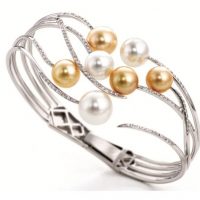“Pearls are always appropriate”
– Jackie Kennedy

Some of the World’s Most Influential Women were Huge Fans of Pearls
First Ladies including Michelle Obama and Jackie Kennedy both regularly adorned themselves with pearls while their husbands were in office. In England, Princess Diana was known to have been a huge fan of pearls. Finally, Coco Chanel was a pioneer of fashion and contributed towards making pearls popular as everyday jewellery.

(Image Courtesy of Australian National Maritime Museum)
Pearls Can Take Many Different Shapes
While people believe that all pearls are perfectly round and symmetrical, this is simply not true. They actually come in an array of different shapes. The most common include round, off-round, drop, and baroque. Round-shaped pearls are undoubtedly the most popular ones, but given different budgets and taste, others are admired too.
It Takes At Least 6 Months for a Pearl to Form
Another fun pearl fact! Each type of pearl takes a certain amount of time to develop. Sometimes, the development process can last as long as 24 months. The procedure begins when a farmer delicately implants a tiny nucleus inside the mollusk. The growth of a pearl l is influenced by how long it takes to recover from the implantation. Once this process is over and the mollusk is fully recovered, the pearl begins to grow as the mollusk covers the nucleus with layers of nacre. Chinese freshwater pearls can grow up to 5mm per year while Japanese Akoya pearls only up to 0.3mm.
Pearls are one of the Birthstone For June
Those born in June aren’t just lucky because the month has three birthstones, but more so because one of these gemstones is the pearl. According to the legend, the June birthstone is believed to symbolize purity, clarity, and loyalty. Given its symbolic meaning and captivating beauty, the pearls are an especially great gift for anyone born in this month.





